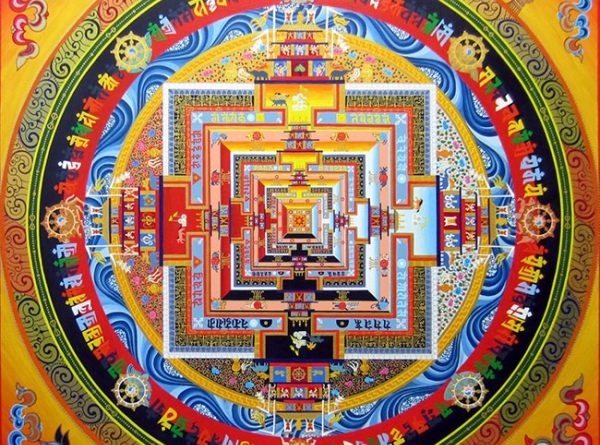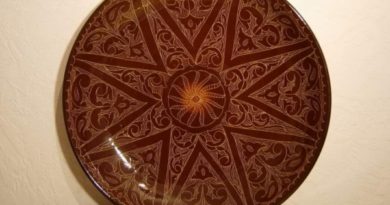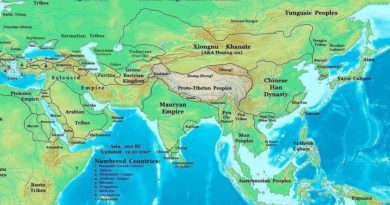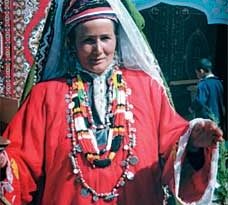Buddhist Mandalas and Symbolics of the Samanids
1. Mandala on the Coin of Amir Mansur ibn Nukh
At the Institute of Archaeology of the Academy of Sciences of RUz in Samarkand there is an unusual Samanid coin of 969-970 with the names of amir Mansur ibn Nukh and Akhmad ibn Mansur on. This is a copper felse of traditional Muslim style but with square sign having non-Islamic symbolics. Inside of the circular inscription there is a square framed with linear text. A circle with eight-petal “daisy” is escribed in the square (fig.1). At the first look, this is a pre-Arab symbol, which the Abbasid vicarious rulers stamped on their coins. For example, the coin of Samarkand striking from 760 – 761 contains a solar sign of rosette and a symbol of fertility in a form of three points, and the Takhirid coin from Khorezm (1, p.101; fig.2) has “well-rounded swastika”. Combination of the name of Allah and non-Islamic sacred signs on the coins is well correspondent with the policy of cultural compromises of the Abbasids and Samanids. This legalized local cults, at the same time, including them in the circle of the Islam culture and subordinating them.
However, it is notable another thing. Symbolic composition on the felse of Mansur ibn Nukh is identical with classic mandala – sacred symbol of the northern directions of Buddhism: Mahayana, Vadjrayana and Tantrism spread in China, Tibet, Central Asia and Eastern Turkistan at the Early Middle Ages. “Mandala” in Sanskrit means “sacred circle”. This is also ritual and magic circle, until now being in practice of Lamaism and Tantra-yoga. Classic mandala contains a triad of escribed geometric figures: outer circle – square – inner circle (fig.3). The inner circle usually contains eight-petal “flower” (2, p.339). Under the oriental tradition, from the ancient times, mandala had being interpreted as a cosmogram.
“Square in the circle” specifies balance of the Earth and Space. The circle symbolizes the Universal in its integrity: out of it – Chaos, inside – harmonic Space. The Circle is also a symbol of Movement, circulation of the roof of heaven. The square means the Earth. Its sides are related to four space orientations. The square is a primo symbol of the Harmony of the human world, expressing initial acts of its establishment. Legendary hero in “Vedi” and “Avesta”, Yima won Chaos and built square Vara, so founding the order. In ancient China the square was a symbol of perfection and world order. The symbol of “square in circle” reveals the order of the world as eternal integrity and interconnection of the Earth and Space. This interprets their relation as a balance, order and harmony in a process of eternal movement.
“Circle with a flower in the square” points the source of Life on the Earth. Direct interpretation of “flower”, as a solar symbol says for the Sun as a source of divine universal energy. Traditions of Vadjrayana and Tantrism have eight-petal flower as an element of the ritual sign “yantra”. Here, it symbolizes the natural, yin and copulative reins. The centre of “yantra” is a place of a sacred object location – a deity, its attribute and symbol. As a rule, this is a machismo – vadjra (“club of thunder”) or phallic symbol. The deity called is coming down the sky onto the central point of “yantra” and doing the action (“inseminate the flower”) giving abundance and luck.
Eventually, classic mandala can be interpreted as harmonic formula of the World Order: Space – Earth – Energy of Life. Its laconic form expresses early medieval natural philosophic concepts and ritual traditions of the Buddhist oriental cultures. At the Early Middle Ages the symbol “square in circle” was recognized Chinese sign standard and was reproduced in a form of coins with a square hole. Striking of such coins in Sogd (fig.4) in the VII – VIII cc. meant recognition of dependence on the Chinese empire of Tyan. Mandala with eight petal flower in the center as a Buddhist symbol appeared in the period of Tantrism formation, on the turn of the VIII – IX cc. when was formed the tradition to expose principal tantrist ideas in a graphic form of mandala. The original language of symbols was worked out for their interpretation. Modern coloured sand mandalas in Tibet are further developing their early medieval prototypes [10]. However, could the Buddhist symbol appear on a Samanid coin? Was it possible that the Samanids could have some relations with Buddhism and Tibet culture?
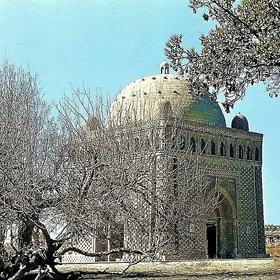 2. Oriental Contacts of the Samanid Culture
2. Oriental Contacts of the Samanid Culture
Let’s remember that the founder of this dynasty, Saman was, on the one version, from Fergana and according to another, from Balkh or Termez. From Chinese written sources and archaeological materials it is known that these regions before the Arab conquest had contacts with Buddhist culture. In Tokharistan were excavated the Buddhist complexes of Karatepa and Fayaztepa in Old Termez, monastery of Adjinatepa, sanctuaries of Kalai Kafirnigan and Kafir-qala, stupa Chor-Digak in Chaganian and the temple in Kuva, the Fergana valley. On the territory of Old Termez, Chaganian, Shuman, Khavamaran and Kobadian, in the VII c. operated tens of the Buddhist monasteries, and even in the early VIII c. in Tokharistan “king and elite, and people” confessed Buddhism. The Arab expansion caused total migrations of the Buddhists eastward, first of all, to Eastern Turkistan where Buddhism became mass religion.
From the end of the VIII c. the Tibet state becoming stronger achieved some victories upon the Tyan Empire and until the 60s of the IX c. had dominated in Eastern Turkistan. Buddhism became the official religion in Tibet. For several decades the opposition of the Caliphate and Tibet armies had continued. In some years, almost half of the Tibet army was involved in the military campaigns. The Tibetans reached Samarkand and at the beginning of the IX c. supported the anti-Abbasid revolt of Rafi ibn-Lyais in Maverannahr. The Samanids came forward at the suppression of this revolt; as the award, they got Samarkand, Herat, Ustrushana, Shash and Fergana. At the time of Akhmad ibn Asad (841 – 864), when the Samanids separated from the Caliphate their central domain was in Fergana.
The Fergana valley, where at the end of the X c. was minted the coin of Mansur ibn Nukh, was the eastern “gate” of Central Asia in the international trade with China through Eastern Turkistan. Its upraising happened at the reign of the Samanids. Their possible partners were the Sogdians from eastern colonies existing in the biggest cities of Central Asia and Far East: Kuch, Lyanchou, Dunhuang and Loyang from the IV – VII cc. In the Tyan capital, Chan’an the quarters were inhabited by the migrants from Central Asia (4, p 84). In the VIII – X cc. the Sogdians enjoyed the political influence in the Uyghur principality of Ganchou, and in Dunhuang and Guachou, in the X c. they even moved the Central Asian, Tsao dynasty to power. The Buddhist mandala on the Samanid coin could give additional guarantee to its recognition in the trade transactions with the East. Probably, this stressed some contacts with the Buddhists from eastern Sogdian colonies.
The Buddhist symbol on the coins could mean the demonstration of the Samanids’ open policy, their readiness for compromises with eastern cultures. If the Abbasids included the achievements of the West, in particular Greek natural philosophy, into the Islamic picture of the World, the Samanids initiated the adaptation of values of the Oriental civilizations. Thus, Samarkand became the biggest, at the Middle East, paper manufacturer, taking this technology from China and Eastern Turkistan. It is worthy to note that operations with abstract symbols have direct connection with development of mathematics. Geometric mandalas as semantic invention of Buddhism obtained universal significance, which can be compared with Indian (Arabic) figures, Euclidean geometry and epicycles of Ptolemy. Geographically they might be created in Eastern Turkistan as well as in Central Asia. Typically, Fergana became a birthplace of the greatest mathematician and astronomer of the IX c., Akhmad al-Fargani.
3. Square Mandala from the Caves of Dunhuang and Mausoleum of the Samanids.
Single minting of the coins with a Buddhist symbol may have different interpretation. However, the epoch of the Samanids had preserved another Buddhist symbolic composition. Nearby the walls of the Samanid capital, Bukhara, on the turn of the IX – X cc. was constructed royal memorial – mausoleum of the Samanids. Each of its four walls, in arch tympans contains a famous square symbol (fig.5). Geometrically, it is simple, there are sequentially escribed: outer square > square turned at diagonal axis > inner square > circle. The analogues of this symbol can be found in China, in wall paintings of the caves of Dunhuang – the biggest early medieval Buddhist center of Eastern and Central Asia. The sign crowns the ceiling of the world “tent” in the caves dated from the VI c. (№ 249 and № 285), where are playing the scenes of the Buddhist mythology.
Since the Dunhuang variant is more detailed, it gives a key to the interpretation of semantic meaning of Dunhuang-Samanid mandala. Central (“green”) square presents the Earth = Field of Life. The Earth (Field) contains in its centre the inseminated (seeds inside the circle) Yin (round). From this centre towards all orientations (4 basic directions + 4 diagonal) Life (vegetative element of the outer contour is richer than of the inner) is developing. B. Ribakov thinks that such compositions played a role of cleaning the space from evil forces: “Thanks to such balance of forces it is achieved full emanation of kind forces and full circular defense from the evil existing everywhere” (7, p.555). Thus, if classic mandala is universal , the mandala of Dunhuang-Samanids is earthen and presents universal formula of Life development.
Let us also pay attention to the fact that the sign from the mausoleum of the Samanids presents a flat projection of the mausoleum itself. This is caused by the connection “cube-square” and “cupola-circle”, analogy of 40 “pearls” and 40 arches of the mausoleum. Three-dimension composition of the mausoleum with the arch openings at each of four sides reflects diagonal location of squares in the mandala. Unexpected link of the flat mandala and architectural form can be explained within Buddhist tradition. The mandala in Tantrism is a formal form of three-dimension sacred palace which is true mandala – a house for visualized god. This complicated architectural structure must be reproduced in mind at the time of meditation practice. Samples of wooden palaces of tantric deities as relicts are at the Tibet monasteries where monks have special training to imagine and reproduce in mind the palaces given in wooden models [11].
4. Double Mandala at Ak-Astana-baba
Two other mandalas of the Samanid or close period (turn of the X – XI cc.) were revealed in 2001 in the region of ancient Chaganian on the facade of the mausoleum of Ak-Astana-baba. Earlier they were hidden by latest annex. The author of this article, Yu.Tuichieva and M. Bulatov (8, p. 22 – 25; 9, p. 12 – 15) offered a version of the interpretation of these symbols. The right composition at Ak-Astana-baba (fig.5) gives a version of world order close to the classic. The link of Life with universal energy of Sun, expressed in a form of flower inside the square, is exposed here as a spiral plant with points-seeds inside the Sun. At Ak-Astana-baba we meet another ancient oriental sign – spiral that symbolizes eternal transformation, circulation and rebirth of Life. The second (left) sign at Ak-Astana-baba reflects symbolism of the nature, like the square mandala of the Samanids (fig.9). A place of round Yin here is occupied by the composition of the Sun and escribed spiral-shaped Plant. The idea of Life development within the space is transmitted by means of two circles of “spires”, which forms in the outer circle are simpler than in the inner one.
Principal difference of the signs at Ak-Astana-baba – substitution of a square by more complicated seven-point star. Here the harmony of Square connected with the Earth is changed by the Harmony of seven-point star connected with the Universe (seven planets, seven week days, seven spheres etc.). This star, in many religious systems, is deemed a magic, mystic sign, what makes it ideal basis for ritual meditations. Considering achievements of Islamic mathematics and natural philosophy in the IX – X cc., earlier was done a hypothesis on the link of Ak-Astana-baba’s signs with the Ishmaelites, which were in the ascendant in the state of the Samanids in the X c. (8, 9).
Analogy of classic mandala and mandala of Dunhuang-Samanids and signs at Ak-Astana-baba causes the idea that these two mandalas also might be semantic couple. Classic mandala with priority of the circle, like the right sign at Ak-Astana-baba, is Yang sign. It corresponds with semantics of the circle as a symbol of the Sky, which in the East is presented by male deity, “inseminating” the Earth-Square. The square mandala, along with the left sign at Ak-Astana-baba, exposes “female”, life-creative sign. Dual composition of such complicated signs corresponds with a key role of Yin and Yang in the world order, interconnection of male and female elements as a foundation of Life. The ancient Chinese canon “The Book of Changes” compiled in the period of the Tsun dynasty (the X – XIII cc.) introduces for this basic concept of the Chinese cosmologic system a sign of the Great Frontier, wide-known today – “tai-chi” based on the circle and spiral (4, p.299 – 302). All these universal compositions of good forces were interpreted as powerful protective symbols, able to protect from the evil forces.
Non-Islamic sacred formulas on the coin and royal mausoleum give the evidence for that the culture of the Samanids was not limited with the Islamic tradition. Probably, declaration of independent, from the Abbasid Caliphate, state of the Samanids required, for cultural sovereignty, non-Muslim cult symbols. Unexpected is their oriental, very likely, Buddhist roots, which can reveal a new, hidden till now, feature of the Samanid dynasty. The construction in Bukhara of unequalled masterpiece – three-dimensional mandala of the Samanid mausoleum as well as typological innovation of signs from Ak-Astana-baba allow to presume that such complicated symbolics was not “export” but domestic product of early medieval civilization of Central Asia. In this case, the symbolics of the Ishmaelite and later Sufi traditions could be going from this source.
Author: Alexey Arapov

